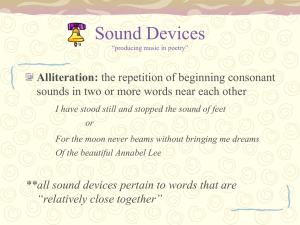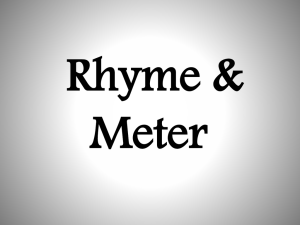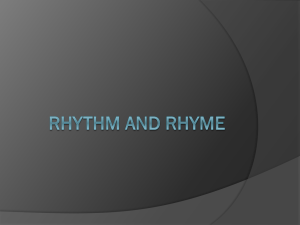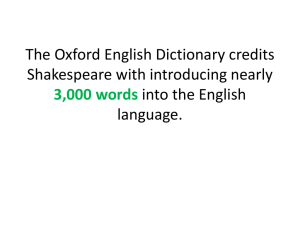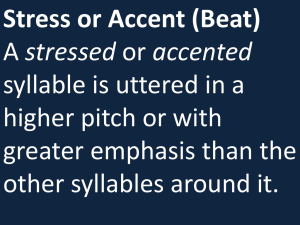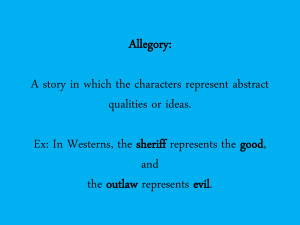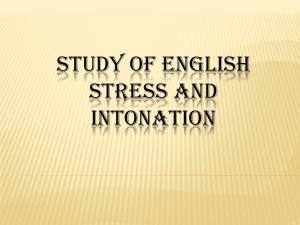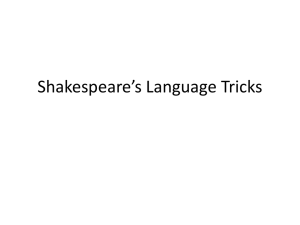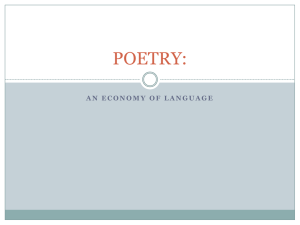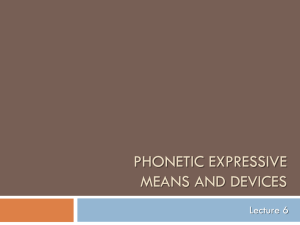Terms for Discussing Prosody
advertisement
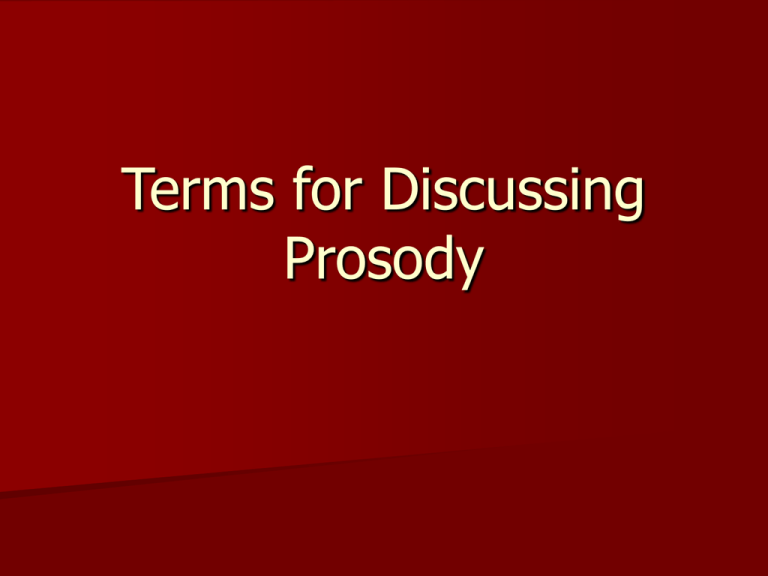
Terms for Discussing Prosody What is prosody? The term “prosody” refers to discussions of the kinds of stressed and unstressed syllables in poems. “Scansion” or “scanning” is the process of marking the beats in a poem. Understanding the patterns of stressed and unstressed syllables in a poem (the “rhythm” of the poem) is necessary if you want to understand sonnets and other poems with a specific form. How do I know what’s stressed and not stressed? Say the word out loud as you naturally would, but listen to which syllables are emphasized. Trial Taxes Upset Retain Badminton Government Pirouette Write down your answers, using capital letters for the syllables that you emphasized. Is this what you said? TRI-al TAX-es up-SET re-TAIN BAD-min-ton GOV-ern-ment pir-ou-ETTE Marking Syllables Stressed and unstressed syllables in poetry are marked above the syllable. A strongly accented syllable is marked with an accent mark like a little forward-leaning slash or apostrophe. An unaccented syllable is marked with “breve,” which is the shallow u-shaped mark that you see in dictionaries to indicate a short vowel. It’s hard to reproduce those in PowerPoint, so for these exercises, the system of capital and lower-case letters is used. Kinds of feet A unit of stressed and unstressed syllables is called a “foot.” Each of those words represents a different kind of foot. Trochee A unit of STRESSED-unstressed syllables (sounding like DA-dum) is called a trochee (or a “trochaic’ foot). TRI-al STRESSED-unstressed (DA-dum) TAX-es STRESSED-unstressed (DA-dum) Iamb A unit of unstressed-STRESSED syllables (da-DUM) is called an iamb (or iambic foot). up-SET unstressed-STRESSED (da-DUM) re-TAIN unstressed-STRESSED (da-DUM) Dactyl A unit of STRESSED-unstressedunstressed syllables is called a dactyl (or “dactylic” foot) BAD-min-ton (DA-dum-dum) GOV-ern-ment (DA-dum-dum) Anapest A unit of unstressed-unstressed-STRESSED syllables is called an anapest (anapestic foot). An anapestic meter—that is, a poem that uses a lot of anapestic feet—is often called a “galloping” meter because it sounds like a horse running: da da DUM da da DUM da da DUM da da DUM Pir-ou-ETTE (da-da-DUM) Note Note: These are just examples within words. In a poem, a foot can stretch across a number of words. Example: “When I consider how my light is spent” might be pronounced (scanned) like this: “when I conSIder HOW my LIGHT is SPENT” da-DUM da-DUM da-DUM da-DUM da-DUM Iambic Pentameter That pattern – da-DUM da-DUM da-DUM da-DUM da-DUM is called “iambic pentameter.” – “Iambic” because the feet are iambic (daDUM) – “Pentameter” because there are five feet in a line. Fun Facts about Iambic Pentameter All of Shakespeare’s plays are written in unrhymed iambic pentameter (called “blank verse.” Iambic pentameter is the meter used in sonnets, which are composed of 14 lines of rhyming iambic pentameter. Iambic pentameter is the closest poetic line to natural speech. Counting Feet Iambic pentameter is a very common meter for poetry, but poets can use any number of feet in a line. Other common numbers of feet: tetrameter (4 feet) and trimeter (3 feet) Look at the next slide for all the names. Naming the number of feet 1 2 3 4 5 6 7 8 foot = monometer feet = dimeter feet = trimeter feet = tetrameter feet = pentameter feet = hexameter feet = heptameter or “the septenary” feet = octameter Odd Kinds of Feet Sometimes you’ll find two stressed or two unstressed feet in a row, usually for emphasis. A whole poem won’t be this way, however. Spondee stressed stressed Pyrrhic unstressed unstressed Ready to read aloud? The best way to scan a poem (that is, to mark its stressed and unstressed syllables) is to read it aloud. Here are some examples for you to read aloud. As you read them, mark the patterns on a piece of paper. Helpful Hints Mark the stressed syllables first and then fill in the unstressed syllables. BE LOUD! It helps if you bang on a desk or table to emphasize the stressed syllables of the word. That’s how we do this in my face-to-face class. After you’ve marked the stressed and unstressed syllables, divide the lines into feet. Ready? Example 1 Clue: This is predominantly iambic. The curfew tolls the knell of parting day, The lowing herd wind slowly o'er the lea, The plowman homeward plods his weary way, And leaves the world to darkness, and to me. When you say this aloud, what syllables are stressed? Mark them with a “strong” mark above the syllable. Sounding out the Rhythm The CURfew TOLLS the KNELL of PARTing DAY, The LOWing HERD wind SLOWly O’ER the LEA, The PLOWman HOMEward PLODS his WEARy WAY, And LEAVES the WORLD to DARKness, AND to ME. Explanation This is iambic pentameter. Multisyllabic words are especially helpful; for example, you would say CURfew, not curFEW and PARTing, not partING, so the accented syllables in those words would help you to determine the pattern. The poem is Thomas Gray’s “Elegy Written in a Country Churchyard.” Example 2 Tyger, tyger, burning bright In the forest of the night What immortal hand or eye Could frame thy fearful symmetry? --Say this quatrain (four lines of poetry) aloud and mark the accented syllables. Where are the strong syllables? Sounding out the Rhythm TYger, TYger, BURNing BRIGHT IN the FORest OF the NIGHT WHAT imMORtal HAND or EYE COULD FRAME thy FEARful SYMmetRY? Explanation Note how the fourth line begins with a spondee, or two-syllable foot in which both syllables are accented. Also, there are four accented syllables but only three unaccented syllables. This is common, since it prevents the poems from being too “sing-songy.” The meter here would be trochaic tetrameter (four beats), even though the unaccented syllables at the end are missing. The poem is William Blake’s “The Tyger.” Example 3 Dactylic This is the forest primeval. The murmuring pines and the hemlocks, Bearded with moss, and in garments green, indistinct in the twilight, Stand like Druids of eld, with voices sad and prophetic. --Say the first line aloud and mark the stressed syllables. Explanation This meter is common for classical epics, and Longfellow here is imitating epic meter: dactylic hexameter. However, it is a meter less commonly used in English. THIS is the FORest primEVal. The MURmuring PINES and the HEMlocks, The poem is Henry Wadsworth Longfellow’s “Evangeline.” Example 4: Anapestic 'Twas the night before Christmas and all through the house, Not a creature was stirring, not even a mouse. The stockings were hung by the chimney with care, In hopes that Saint Nicholas soon would be there. Say this aloud and mark the stressed syllables. See how it “gallops”? Sounding out the Rhythm 'Twas the NIGHT before CHRISTmas and ALL through the HOUSE, Not a CREAture was STIRring, not EVen a MOUSE. The STOCKings were HUNG by the CHIMney with CARE, In HOPES that Saint NICholas SOON would be THERE Explanation The rhythm sounds something like this: da da DUM da da DUM da da DUM da da DUM. See? Galloping meter. This is anapestic tetrameter. The poem is Clement Clark Moore’s “A Visit from St. Nicholas.” Test-Yourself Quiz Now that you’ve tried the examples here, try the test-yourself quiz on prosody at http://www.wsu.edu/~campbelld/amlit/qui z/prosquiz.htm Note: This is NOT a graded quiz, and it is not in Angel. Anybody can take it, and the results are available only to you.
